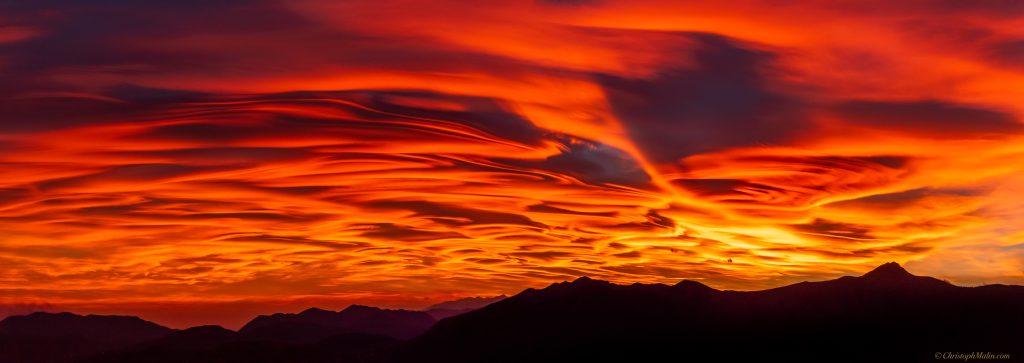First documented PSC’s sighting above Switzerland and Italy, December 22nd, 2023
Main Cloud “Bowl”Structure similar to a famous Lenticularis Display in 2017 at similar location due to Lago Maggiore Topography.
For all Images for the Scientific Community to Download see: https://www.picdrop.com/christophmalin/FHaoD1EKaE
—————
Date: October, 29th, 2017
Photos and Videos Recorded from 5:28 pm to 18:49
Location: Sentiero Lago di Lugano, Monte Bar
1313 m ASL, 46°5’48”N, 8°59’7”E, looking West, GPS Direction 240.843 M
Panoramas created in Lightroom
Camera: Nikon D750 with AFS 24-70/2.8, iPhone 8
In 2017, while producing a Bikeride Travel Story for MTB Magazine with Friends to Monte Bar in the Locarno Area, Tessin, Switzerland, during strong cold Northern Foehn Winds, we encountered the most impressive Lenticularis Cloud Display ever.
We had Lights on the Bikes, and I took the time to shoot some Pano and Video with D750 and iPhone 8 until it got too dark and we had to move on.
2nd Event – PSC Display, Tessin, Switzerland, December 2023
Date: December 22nd, 2023
Photos and Videos Recorded ca. from 3 pm to 5 pm
Location: Sentiero Lago di Lugano, Monte Bar
1595m ASL, 46°6’29”N, 9°2’4”E, looking Southwest, GPS Direction 208.866 M
Panoramas created in Lightroom
Camera: iPhone 15 ProMax, Insta360 Ace Pro Chest Mount
In 2023, while producing Images for Mountainbike Company Simplon with Friends again to Monte Bar in the Locarno Area, Tessin, Switzerland, during very strong cold Northern Foehn Winds, we encountered a very impressive PSC Cloud Display (https://en.wikipedia.org/wiki/Polar_stratospheric_cloud).
I took the time to shoot some Pano and Video with iPhone 15 Pro Max and a Insta360 Ace Pro while riding, until it got too dark and we had to move on to get down to the Valley.
What we found very interesting, is that at both Events with similar Line of Sight we see the same main Bowl Structure forming, probably caused by the Topography of Lago Maggiore and nearby Mountains which can reach up to 2000m ASL.
I have sent these Images to Dr. Paul Newman, NASA Scientist, and received a great Response which explains the PSC Sighting:
———
Dear Christoph,
Happy New Year!
Great polar stratospheric cloud (PSC) photos! This is very unusual.
PSCs typically form at temperatures < 195K (-78 C) for *normal* stratospheric (> 16 km altitude) conditions in this year. First, the Hunga volcanic eruption in January 2022 has led to strange conditions in the stratosphere. The eruption significantly increased the amount of water in the usually very dry stratosphere. Hence, because of more water, the PSCs are probably forming at slightly higher temperatures (196-197 K). Second, the stratospheric weather conditions were odd, pushing cold temperatures over Europe for that day (see: https://acd-ext.gsfc.nasa.gov//Data_services/Current/arctic/plots/T_2023122200_A_50.png). This plot shows the flow field and temperatures at 0 GMT on Dec. 22 on the 50 hPa (~20 km altitude) surface. As you can see, temperatures were 196-200K over Northern Italy on that day. Third, the flow field from the troposphere to the lower stratosphere was aligned to force atmospheric waves (known as gravity waves in the atmospheric community) that propagated into the stratosphere. These waves caused localized swings of the broad scale temperature field below the PSC formation temperature. The structural appearance of the PSCs reflects these localized swings.
PSCs are important because they activate stratospheric chlorine trace gases from benign forms (HCl and ClONO2) to forms that can rapidly deplete ozone (Cl2 and ClO).
Peace to all, Paul
Dr. Paul A. Newman
Chief Scientist for Earth Sciences, NASA GSFC
http://acd-ext.gsfc.nasa.gov/People/Newman/
“Give peace a chance.” – J. Lennon
———–
My further Question to Dr. Newman was: „As you can see that prominent „Bowl“ Structure from 2017 at the Lenticularis, kind of starting to form again in 2023 at the Dawn Images at a similar Area… is it even possible that the Topography of the Valleys below influence the forming at such high altitudes? So you say the the alignment of the flow field from the troposphere to the lower stratosphere forced these atmospheric waves.“
Answer by Dr. Newman:
„Gravity waves propagate upward, but also propagate horizontally. The detailed vertical wind profiles and *regional* topography are both necessary to model the temperature perturbations. In your picture, the vertical stacking can be seen reveailing the vertical wave structure. The waves are forced by the flow over the topography, just like strong stream flow over a rock in a river. It’s typically very hard to pinpoint the topographical source, since these waves can propagate large horizontal distances.“
Kind regards,
Christoph Malin
Christophmalin.com
https://twanight.org/profile/christoph-malin/
https://www.eso.org/public/outreach/partnerships/photo-ambassadors/#malin












No responses yet